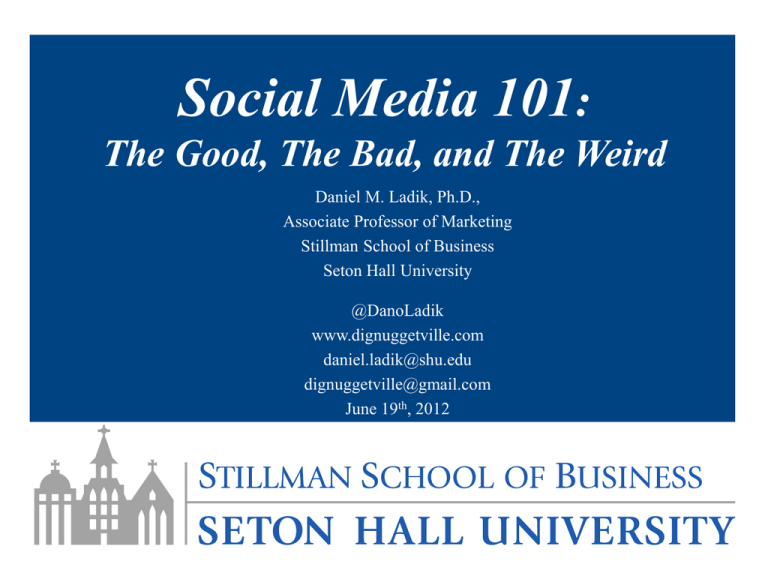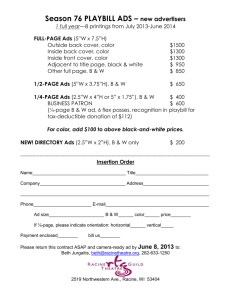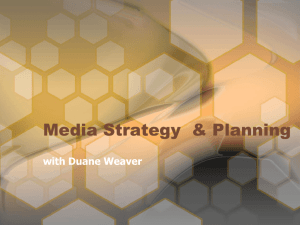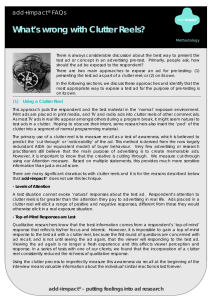Social Media 101 Adj
advertisement

Social Media 101: The Good, The Bad, and The Weird Daniel M. Ladik, Ph.D., Associate Professor of Marketing Stillman School of Business Seton Hall University @DanoLadik www.dignuggetville.com daniel.ladik@shu.edu dignuggetville@gmail.com June 19th, 2012 The Weird? • The Wild World of Social Media – http://www.youtube.com/watch?v=ZQzsQkMFgH E • Social Media Explained in one Instagram – http://authentic.ly/social-media-explained-in-oneinstagram/ Breaking Down Social Media • Social: – marked by or passed in pleasant companionship – the two-way interaction of the individual and the group; the formation of cooperative and interdependent relationships • Media: – the means of communication, as radio and television, newspapers, and magazines, that reach or influence people widely Social Media • Social media are the means of communication based on interdependent relationships and cooperation among friends and associates – Enhanced by the anytime, anywhere benefits of the Web and mobile technologies – Built around online communities Social Media Marketing • Social media marketing is the utilization of social media technologies, channels, and software to create, communicate, deliver, and exchange offerings that have value for an organization’s stakeholders. A Brief History (Video) of Social Media Note: The following video can be found on iTunes U. Search for the University of South Florida – select Social Media – select the “Socially Digital” show – watch to the 3:30 min mark Pros and Cons of Key Advertising Media EXHIBIT Type of Media PROS CONS Television Combines multimedia Appeals to multiple senses Works for both mass coverage or selected markets Infomercial option Radio Quick placement and high message immediacy Easy selectivity by market and station programming Low cost Geographic flexibility Audio only Short shelf life Din of competing ads Newspapers Flexible Timely Highly credible medium Magazines Many titles, offers high geographic, demographic, and lifestyle selectivity Good reproduction quality and color High pass-along rate Long lead time for ad placement due to production Final location of ad within the publication often cannot be guaranteed Outdoor Space and structure limits creative execution Sometimes requires longer than desired commitments to a location Public discontent over environmental clutter Direct Mail High audience selectivity Creates feel of one-to-one marketing Flexible Overuse and “junk mail” image Too many competing ads Relatively high cost Electronic/web Reader in control of exposure (click-through) SPAM Variations in connectivity speed and computers Repeat exposure in heavy traffic areas Relatively low cost Fewer competing ads Easy geographic targeting Interactive capabilities (2-way communication) Flexible Timely Low cost per exposure Impressions are fleeting Short shelf life Din (clutter) of competing ads TiVo effect – cutting out ads High cost Short shelf life Big city and national papers can be very costly Poor reproduction quality, especially in color Low pass-along rate Shifting to Social Media Source: David Armano, Logic + Emotion, Online: darmano.typepad.com The Realm of Social Media http://www.mirnabard.com/2010/02/15-categories-of-social-media/ Zones of Social Media Exemplar Channels The GOAL! • In my eyes, the main goal is to BUILD a user community • It is cheaper to market to existing customers than it is to find new customers • New customers tend to buy less than repeat customers • Repeat customers do more pro-social behaviors such as positive word-of-mouth • Social Media is an excellent means to accomplish these objectives (ROI) How can I be helpful?





